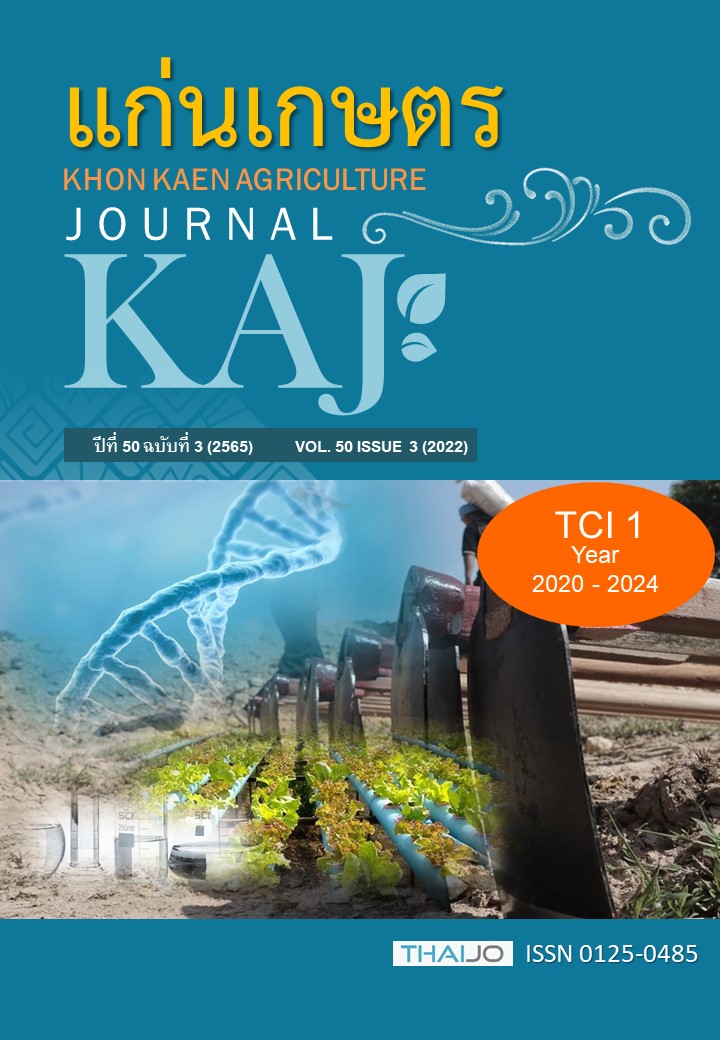ทางเลือกการใช้สารกำจัดวัชพืชในการจัดการหญ้าข้าวนกต้านทานสารพีน็อกซูแลมในนาข้าว
Main Article Content
บทคัดย่อ
หญ้าข้าวนกเป็นวัชพืชหลักที่เป็นปัญหาสำคัญและก่อให้เกิดความเสียหายในนาข้าวได้มากถึง 80 เปอร์เซ็นต์ จากการสำรวจของเกษตรกร พบว่า การใช้สารกำจัดวัชพืชในกลุ่มที่ยับยั้งการทำงานของเอนไซม์ ALS ไม่สามารถควบคุมหญ้าข้าวนกได้ การศึกษาในครั้งนี้จึงมีวัตถุประสงค์เพื่อพิสูจน์ให้แน่ชัดว่า ประชากรของหญ้าข้าวนกในพื้นที่ อ.ลาดหลุมแก้ว จ.ปทุมธานี มีการพัฒนาความต้านทานต่อสาร penoxsulam ซึ่งเป็นสารในกลุ่มที่ยับยั้งการทำงานของเอนไซม์ ALS จริงหรือไม่ เก็บตัวอย่างเมล็ดหญ้าข้าวนกจากแปลงเกษตรกรที่มีการรายงานว่าพบปัญหาที่เกิดจากการใช้สาร penoxsulam เพื่อทำการศึกษาตอบสนองทางสรีรวิทยาของหญ้าข้าวนกที่มีต่อสาร penoxsulam วางแผนการทดลองแบบ split plot design in CRD จำนวน 4 ซ้ำ ปัจจัยหลัก คือ อัตราการใช้สาร penoxsulam มี 6 อัตรา คือ (0, 7.03, 14.06, 28.12, 56.24 และ 112.48 กรัมสารออกฤทธิ์ต่อเฮกตาร์) และปัจจัยรอง คือ หญ้าข้าวนกไบโอไทป์ที่อ่อนแอและต้านทานสาร พ่นสารที่ 12 วันหลังหว่าน เมื่อพิจารณาค่า I50 จากความเป็นพิษ และค่า GR50 จากความสูงและน้ำหนักสด พบว่า ไบโอไทป์ต้านทานสารมีค่าดัชนีของความต้านทานสารสูงกว่าไบโอไทป์ที่อ่อนแอมากถึง 18.08-84.87 เท่า ต่อมาทำการศึกษาความต้านทานข้ามของหญ้าข้าวนกไบโอไทป์ต้านทานสารไปยังสารกำจัดวัชพืชชนิดอื่นๆ ในกลุ่มที่ยับยั้งการทำงานของเอนไซม์ ALS วางแผนการทดลองแบบ CRD จำนวน 4 ซ้ำ พบว่า การใช้สาร bispyribac-sodium, pyribenzoxim และ triafamone ตามอัตราแนะนำ ซึ่งเป็นสารในกลุ่มที่ยับยั้งการทำงานของเอนไซม์ ALS ไม่สามารถควบคุมหญ้าข้าวนกไบโอไทป์ต้านทานสาร penoxsulam ได้ จากนั้น ทำการศึกษาความต้านทานสารหลายกลุ่มของหญ้าข้าวนกไบโอไทป์ต้านทานไปยังสารในกลุ่มอื่นๆ ที่มีตำแหน่งการเกิดปฏิกิริยาภายในพืชที่แตกต่างกัน พบว่า สาร profoxydim (สารที่ยับยั้งงานของเอนไซม์ ACCase), propanil (สารที่ยับยั้งกระบวนการสังเคราะห์ด้วยแสง ในระบบแสง II) และ florpyrauxifen-benzyl (สารที่มีคุณสมบัติคล้ายฮอร์โมนพืช) มีประสิทธิภาพควบคุมหญ้าข้าวนกไบโอไทป์ต้านทานสาร penoxsulam ได้ตามอัตราแนะนำ จากข้อมูลการศึกษาในครั้งนี้ เกษตรกรควรมีการสลับหรือหมุนเวียนการใช้สารกำจัดวัชพืชที่มีตำแหน่งการเกิดปฏิกิริยาภายในพืชที่แตกต่างกัน เพื่อควบคุมและลดจำนวนประชากรของหญ้าข้าวนกไบโอไทป์ต้านทานสาร penoxsulam ในนาข้าวต่อไป
Article Details

อนุญาตภายใต้เงื่อนไข Creative Commons Attribution-NonCommercial-NoDerivatives 4.0 International License.
เอกสารอ้างอิง
จรรยา มณีโชติ, ปรัชญา เอกฐิน และ ยุรวรรณ อนันตนมณี. 2560. พื้นที่เสี่ยงต่อการระบาดของหญ้าข้าวนกที่มีกลไกความต้านทานต่อสารกำจัดวัชพืชแบบ multiple resistance ในนาข้าว. น. 2007-2019. ใน: รายงานผลงานวิจัยประจำปี 2560. สำนักวิจัยพัฒนาการอารักขาพืช กรมวิชาการเกษตร.
วัชรา มณฑาทิพย์, จำเนียร ชมภู และ ทศพล พรพรหม. 2560. หญ้าแดง (Ischaemum rugosum Salisb.) ต้านทานต่อสารบีสไพริแบค-โซเดียมในข้าวนาหว่านน้ำตม. น. 933-946. ใน: การประชุมวิชาการอารักขาพืชแห่งชาติ ครั้งที่ 13 ณ โรงแรมเรือรัษฎา จ.ตรัง.
สุตานันท์ โพธิ์สวัสดิ์, สุรพล ฉินทกานันท์, จำเนียร ชมพู และ ทศพล พรพรหม. 2558. การศึกษาหญ้าข้าวนกต้านทานสารบีสไพรีแบค-โซเดียมในนาหว่านน้ำตม. น. 116-117. ใน: การประชุมวิชาการอารักขาพืชแห่งชาติ ครั้งที่ 12. ณ โรงแรมดุสิต ไอส์แลนด์ รีสอร์ท จ.เชียงราย.
Burrill, L.C., J. Cardenas, and E. Locatelli. 1976. Field manual for weed control research. International Plant Protection Center, Oregon State University, Corvallis.
Caton, B.P., M. Mortimer, and J.E. Hill. 2004. A Practical Field Guide to Weed of Rice in Asia. International Rice Research Institute, Los Banos, Laguna, Philippines.
Development Core Team. 2014. R: A language and environment for statistical computing. R Foundation for Statistical Computing, Vienna, Austria. ISBN 3-900051-07-0. Available: http://www.R-project.org. Accessed Feb. 21, 2014.
El-Naddy, M.F., A.M. Hamza, and A.S. Derbalah. 2012. Echinochloa colona resistance to bispyribac-sodium in Egypt-Occurrence and identification. Journal of Plant Protection Research. 1(1): 139-145.
Fischer, A.J., C.M. Ateh, D.E. Bayer, and J.E. Hill. 2000. Herbicide-resistant Echinochloa oryzoides and E. phyllopogon in California Oryza sativa Fields. Weed Science. 48(2): 225-230.
Guoqi, C., Q. Wang, Z. Yao, L. Zhu, and L. Dong. 2016. Penoxsulam-resistant barnyardgrass (Echinochloa crus-galli) in rice fields in China. Weed Biology and Management. 16(1): 16-23.
Heap, I., and I.N. Morrison. 1996. Resistance to aryloxyphenoxypropionate and cyclohexanedione herbicides in green foxtail (Setaria viridis). Weed Science. 44(1): 25-30.
Heap, I. 2022. International survey of herbicide resistant weeds. Available: http://www.weedscience.org. Accessed Jan. 9, 2022.
Ioannis, V., K. Dhima, and T. Gitsopoulos. 2018. Management of penoxsulam- and bispyribac-resistant late watergrass (Echinochloa phyllopogon) biotypes and rice sedge (Cyperus difformis) in rice. Chilean Journal of Agricultural Research. 78(2): 276-286.
Maneechote, C., S. Samanwong, X.Q. Zang, and S.B. Powels. 2005. Resistance to ACCase-inhibiting herbicides in population of sprangletop (Leptochloa chinensis L. Nees) in Thailand. Weed Science. 53(3): 290-295.
Panozzo, S., L. Scarabel, P.L. Tranel, and M. Sattin. 2013. Target-site resistance to ALS inhibitors in the polyploid species Echinochloa crus-galli. Pesticide Biochemistry and Physiology. 105(2): 93-101.
Peng, Q., H. Heping, Y. Xia., B. Lianyang, Y. Qin, and S.B. Powles. 2019. Quinclorac resistance in Echinochloa crus-galli from China. Science Direct. Available: http://www.sciencedirect.com. Accessed Jan. 18, 2021.
Phinyosak, R., and T. Pornprom. 2017. Resistance of Fimbristylis miliacea (L.) Vahl populations to acetolactate synthase-inhibiting herbicides. In: Proceeding of the 26th Asian-Pacific Weed Science Society Conference 19-22 September 2017, at Kyoto Research Park, Kyoto, Japan.
Pornprom, T., P. Mahatamnuchoke, and K. Usui. 2006. The role of altered acetyl-CoA carboxylase conferring resistance to fenoxaprop in Chinese sprangletop (Leptochloa chinensis L. Nees.). Pest Management Science. 62(11): 1109-1115.
Riar, D.S., J.K. Norsworthy, V. Srivastava, V. Nandula, J.A. Bond, and R.C. Scott. 2013. Physiological and molecular basis of acetolactate synthase-inhibiting herbicide resistance in barnyardgrass (Echinochloa crus-galli). Journal of Agricultural and Food Chemistry. 61(2): 278-289.
Sakuma, M. 1998. Probit analysis of preference data. Applied Entomology and Zoology. 33(3): 339–347.
Sripeangchan, M., L. Duy, T. Pornprom, M. Morell and S. Byron. 2019. RinskorTM Active controls ALS-Resistant Echinochloa crus-galli (L.) in Direct Seeded Rice in Thailand. In: Proceeding of the 27th Asian- Pacific Weed Science Society Conference 3-6 September 2019, at Kuching, Sarawak, Malaysia.
Valverde, B.E., C.R. Riches, and J.C. Caseley. 2000. Prevention and Management of Herbicide Resistant Weeds in Rice: Experience from Central America with Echinochloa colona. CATIC, Turrialba, Costa Rica.


